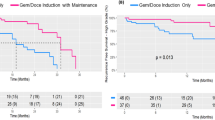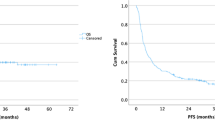Abstract
Background
Non-muscle invasive bladder cancers (NMIBC) tend to recur and progress over time. Bacillus Calmette–Guerin (BCG) is an effective therapy for the treatment of NMIBC in that it reduces both recurrence and progression rates. The present study investigates the causes of BCG failure, with emphasis on those attributable to application errors by the practitioner and/or patient.
Methods
The demographic and histopathological characteristics of 115 patients who underwent TUR-B for primary bladder tumors and who underwent intracavitary BCG in the postoperative period in the Urology Clinic of the İzmir Katip Çelebi University Atatürk Training and Research Hospital between January 2014 and January 2019, were analyzed retrospectively. BCG-refractory patients were compared with non-BCG refractory patients after BCG administration.
Results
The extent of the tumor, and the involvement of the tumor in the bladder trigone and/or the bladder neck were found to increase significantly the likelihood of BCG refractory. When the micturition times of both groups were compared after instillation, the differences between the groups were found to be statistically significant. In the BCG-refractory patient group, the micturition time after instillation was shorter due to the tumor involvement in the trigone/bladder neck.
Conclusion
Some modifiable factors originating from the patient and the tumoral characteristics were found to have an effect on BCG failure. It was further determined that the time until micturition after BCG administration is an important parameter to be considered in the prevention of application deficiencies. We believe these factors should be subjected to careful consideration during patient selection and follow-up.
Similar content being viewed by others
References
Bray F, Ferlay J, Soerjomataram I et al (2018) Global cancer statistics 2018: GLOBOCAN estimates of incidence and mortality worldwide for 36 cancers in 185 countries. CA Cancer J Clin 68(6):394–424
Chavan S, Bray F, Lortet-Tieulent J et al (2014) International variations in bladder cancer incidence and mortality. Eur Urol 66(1):59–73
Burger M, Catto JW, Dalbagni G et al (2013) Epidemiology and risk factors of urothelial bladder cancer. Eur Urol 63(2):234–241
Baltaci S, Bozlu M et al (2015) Significance of the interval between first and second transurethral resection on recurrence and progression rates in patients with high-risk non-muscle-invasive bladder cancer treated with maintenance intravesical Bacillus Calmette-Guerin. BJU Int 116(5):721–726
Babjuk M, Oosterlinck W, Sylvester R et al (2008) EAU guidelines on non-muscle-invasive urothelial carcinoma of the bladder. Eur Urol 54(2):303–314
Catalona W, Ratliff T (1990) Bacillus Calmette-Guérin and superficial bladder cancer. Clinical experience and mechanism of action. Surg Ann 22:363–378
Han RF, Pan JG (2006) Can intravesical bacillus Calmette-Guérin reduce recurrence in patients with superficial bladder cancer? A meta-analysis of randomized trials. Urology 67(6):1216–1223
Kolodziej A, Dembowski J, Zdrojowy R et al (2002) Treatment of high-risk superficial bladder cancer with maintenance bacille Calmette-Guérin therapy: preliminary results. BJU Int 89(6):620–622
Kamat AM, Sylvester RJ, Böhle A et al (2016) Definitions, end points, and clinical trial designs for non–muscle-invasive bladder cancer: recommendations from the International Bladder Cancer Group. J Clin Oncol 34(16):1935
Sylvester RJ, Van Der Meijden AP, Oosterlinck W et al (2006) Predicting recurrence and progression in individual patients with stage Ta T1 bladder cancer using EORTC risk tables: a combined analysis of 2596 patients from seven EORTC trials. Eur Urol 49(3):466–477
Shelley M, Kynaston H, Court J et al (2001) A systematic review of intravesical bacillus Calmette-Guérin plus transurethral resection vs transurethral resection alone in Ta and T1 bladder cancer. BJU Int 88(3):209–216
Kates M, Matoso A, Choi W et al (2020) Adaptive immune resistance to intravesical BCG in non–muscle invasive bladder cancer: implications for prospective BCG-unresponsive trials. Clin Cancer Res 26(4):882–891
Ferro M, Vartolomei MD, Russo GI et al (2019) An increased body mass index is associated with a worse prognosis in patients administered BCG immunotherapy for T1 bladder cancer. World J Urol 37(3):507–514
Borges MD, Franca EL, Fujimori M et al (2018) Relationship between proinflammatory cytokines/chemokines and adipokines in serum of young adults with obesity. Endocr Metab Immune Disord Drug Targets 18(3):260–267
Lin Y, Wang Y, Wu Q et al (2018) Association between obesity and bladder cancer recurrence: A meta-analysis. Clin Chim Acta 480:41–46
Hwang EC, Kim YJ, Hwang IS et al (2011) Impact of diabetes mellitus on recurrence and progression in patients with non-muscle invasive bladder carcinoma: a retrospective cohort study. Int J Urol 18(11):769–776
Ferro M, Katalin MO, Buonerba C et al (2020) Type 2 diabetes mellitus predicts worse outcomes in patients with high-grade T1 bladder cancer receiving bacillus Calmette-Guérin after transurethral resection of the bladder tumor. Urol Oncol 38:459
Dal Moro F, Bovo A, Crestani A et al (2015) Effect of hypertension on outcomes of high-risk patients after BCG-treated bladder cancer: a single-institution long follow-up cohort study. Medicine (Baltimore). https://doi.org/10.1097/MD.0000000000000589
Chen CH, Shun CT, Huang KH et al (2007) Stopping smoking might reduce tumour recurrence in nonmuscle-invasive bladder cancer. BJU Int 100(2):281–286
Rink M, Xylinas E, Babjuk M et al (2012) Smoking reduces the efficacy of intravesical bacillus Calmette-Guérin immunotherapy in non-muscle-invasive bladder cancer. Eur Urol 62(6):1204–1206
Fernandez-Gomez J, Solsona E, Unda M et al (2008) Prognostic factors in patients with non–muscle-invasive bladder cancer treated with bacillus Calmette-Guérin: multivariate analysis of data from four randomized CUETO trials. Eur Urol 53(5):992–1002
Lima L, Oliveira D, Ferreira JA et al (2015) The role of functional polymorphisms in immune response genes as biomarkers of bacille C almette-G uérin (BCG) immunotherapy outcome in bladder cancer: establishment of a predictive profile in a Southern Europe population. BJU Int 116(5):753–763
Segal R, Yafi FA, Brimo F et al (2012) Prognostic factors and outcome in patients with T1 high-grade bladder cancer: can we identify patients for early cystectomy? BJU Int 109(7):1026–1030
Vukomanovic I, Colovic V, Soldatovic I et al (2012) Prognostic significance of tumor location in high-grade non-muscle-invasive bladder cancer. Med Oncol 29(3):1916–1920
Kamat AM, Dinney CP, Gee JR et al (2007) Micropapillary bladder cancer: a review of the University of Texas MD Anderson Cancer Center experience with 100 consecutive patients. Cancer 110(1):62–67
Sengiku A, Ito M, Miyazaki Y et al (2013) A prospective comparative study of intravesical bacillus Calmette-Guerin therapy with the Tokyo or Connaught strain for nonmuscle invasive bladder cancer. J Urol 190(1):50–54
Boehm BE, Cornell JE, Wang H et al (2017) Efficacy of bacillus Calmette-Guerin strains for treatment of nonmuscle invasive bladder cancer: a systematic review and network meta-analysis. J Urol 198(3):503–510
M’Liss AH, Catalona WJ, Ritchey JK et al (1989) Choice of an optimal diluent for intravesical bacillus Calmette-Guerin administration. J Urol 142(6):1438–1441
Nagai T, Okamura T, Tanaka Y et al (2019) Evaluation of the dwell-time and dose difference in intravesical bacillus Calmette-Guèrin therapy. Asian Pac J Cancer Prevent APJCP 20(5):1389
Funding
Not applicable.
Author information
Authors and Affiliations
Contributions
EMY determined the hypothesis of the study. In addition, as the main author, he analyzed and interpreted the data of patients who underwent BCG for bladder cancer. YY contributed to the evaluation of the resulting data. OK made the statistics of the study and interpreted the results. YA compared the results found in the study with the literature data.SNG and SO significantly revised the study.
Corresponding author
Ethics declarations
Conflict of interest
The authors declare that they have no competing interests.
Ethics approval and consent to participate
This study was carried out in the urology clinic of İzmir Katip Çelebi University Atatürk Training and Research Hospital with the approval of the Local Ethics Committee (25.07.2019/Decision No: 78).
Consent for publication
Informed consent was obtained from all subjects for participation in the study.
Decision
At the ethics committee meeting dated 14.02.2019, the requested corrections were made by the researchers and found appropriate, and it was unanimously decided by the members of the ethics committee who attended the meeting that there was no ethical or scientific objection to the study in the centers specified in the application file.
Additional information
Publisher's Note
Springer Nature remains neutral with regard to jurisdictional claims in published maps and institutional affiliations.
Rights and permissions
About this article
Cite this article
Yorulmaz, E.M., Yılmaz, Y., Köse, O. et al. Investigation of the causes of BCG refractory in patients treated with intracavitary BCG as secondary treatment in superficial bladder tumors with transurethral resection. Int Urol Nephrol 54, 533–540 (2022). https://doi.org/10.1007/s11255-022-03104-9
Received:
Accepted:
Published:
Issue Date:
DOI: https://doi.org/10.1007/s11255-022-03104-9




